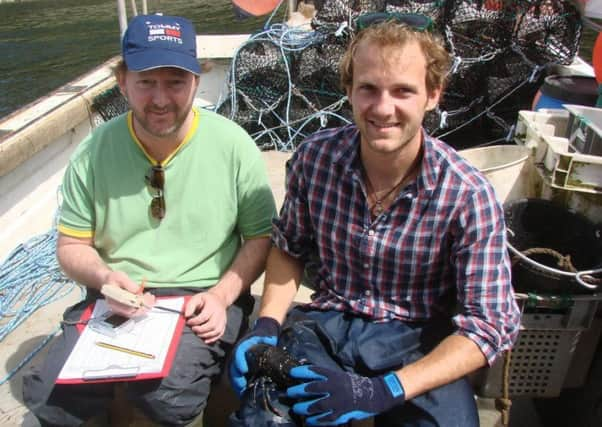Arran no-fishing zone benefits lobsters


Research was carried out over a four-year period in Lamlash Bay by scientists at York and Bangor universities.
Results show the numbers of lobsters found in the area more than doubled in numbers as well as increasing in size over the course of the study.
Advertisement
Hide AdAdvertisement
Hide AdPopulations of velvet crabs and brown swimming crabs were also monitored.
The researchers found that protection in the marine reserve had a positive impact on lobsters, with their density, length and weight all being greater than in those found at other sites.
Catches of egg-bearing female lobsters were also twice as high within the reserve, with these females carried an average of 22 per cent more eggs than their counterparts elsewhere – increasing breeding potential.
Tagging experiments also showed that lobsters have been spreading out from the marine reserve as their numbers grow, thereby boosting local fishing grounds.
However, although adult lobsters are thriving, juvenile lobsters and brown and velvet crab numbers were found to be declining, which the experts believe could be evidence of competitive displacement or predation.
This could be due to the relatively small size of the Lamlash Bay reserve, which was set up by the Community of Arran Seabed Trust (Coast) and was designated as the country’s first no-fishing zone in 2008.
The scientists believe this confirms larger reserves are needed to allow marine ecosystems to recover more naturally.
The reserve, which covers a one square mile area at the north end of Lamlash Bay, is now part of a larger marine protected area (MPA) in the Firth of Clyde that allows limited fishing activities.
Advertisement
Hide AdAdvertisement
Hide Ad“Our findings provide evidence that temperate marine reserves can deliver fisheries and conservation benefits, but they also highlight the importance of investigating multi-species interactions, as the recovery of some species can have knock-on effects on others,” said study supervisor Dr Bryce Beukers-Stewart, a lecturer in York’s environment department.
Dr Leigh Howarth, of Bangor University’s School of Ocean Sciences, added: “Studies into the effects of marine reserves remain scarce in temperate and cold waters and are particularly limited in Europe and the UK.
“However, our research within Lamlash Bay has shown that a wide range of species and habitats can benefit from protection.”
Andrew Binnie, executive director of Coast, said: “These results are very encouraging, especially considering the relatively small size of the No Take Zone.
“They show that well thought out spatial management measures can have a positive impact on the resilience of commercial species such as European lobster and increase female reproductive output.
“The findings bode well for Arran’s 280-square-kilometre marine protected area, legally established in February this year, and for everyone who depends on the sea to make a living.”
But Dr Howarth insists marine reserves are only one part in creating sustainable fisheries.
“It is widely agreed that a combination of managing fishing effort, fishing gears, and establishing protected areas, all of which have received mutual consent from managers, fishers and other stakeholders, is by far the most effective way to restore stocks and marine ecosystems,” he said.